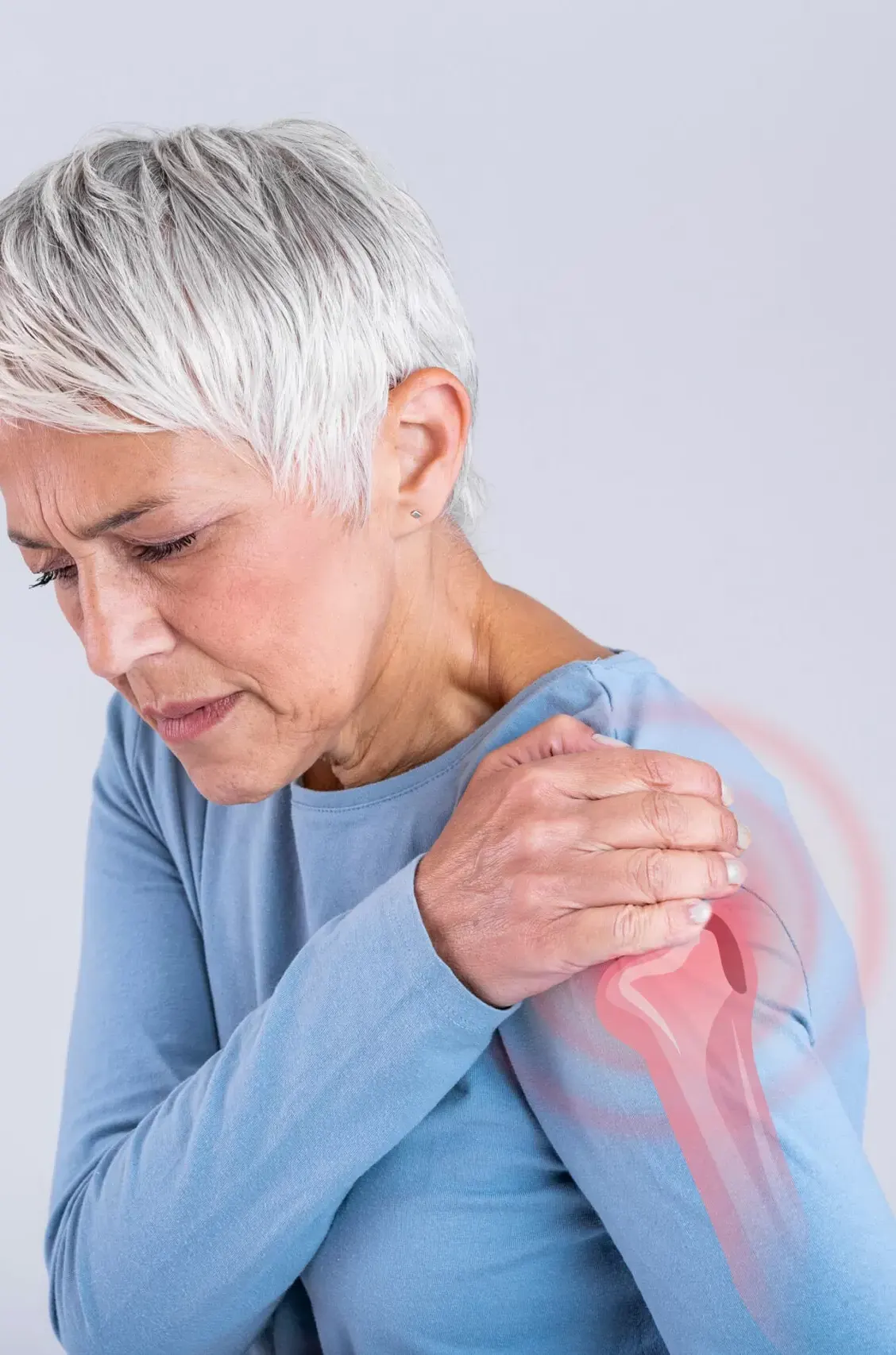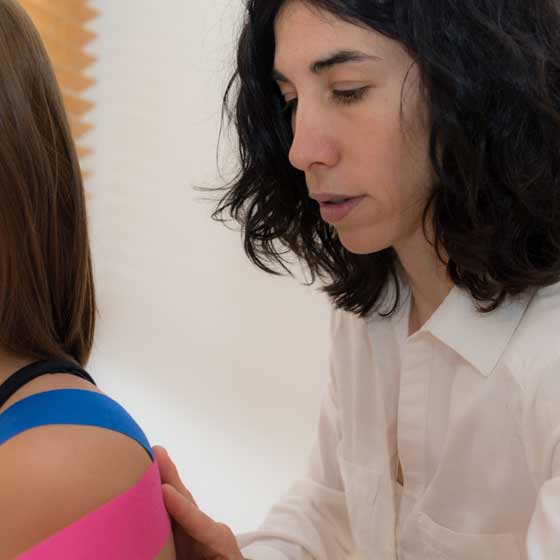Shoulder anatomy
To fully understand shoulder pain, it’s essential to begin with a detailed exploration of the shoulder’s complex anatomy. The shoulder is a highly mobile joint, composed of several key anatomical structures.
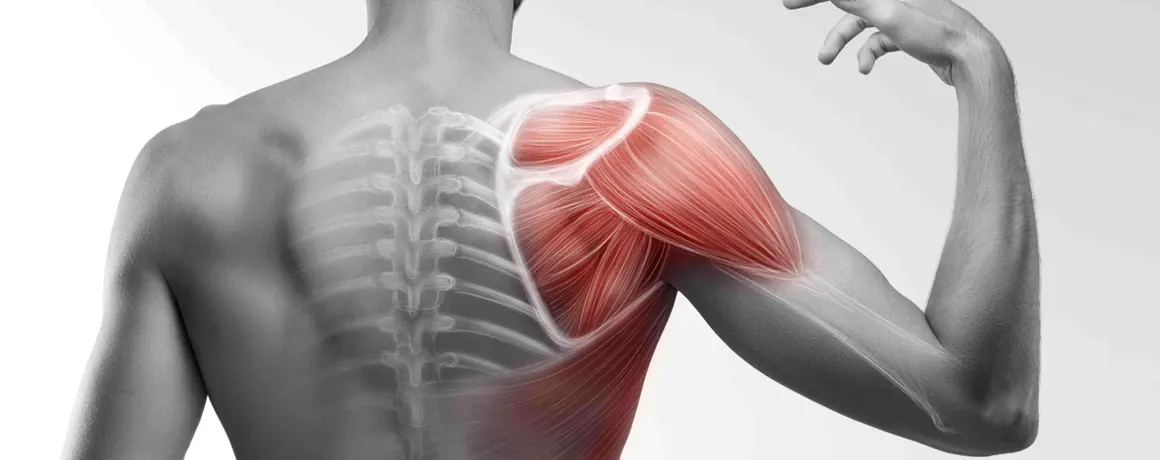
Shoulder bones
The shoulder is made up of three main bones: the humerus, the scapula and the clavicle (collarbone). These bones articulate to form the shoulder joint, which allows a wide range of motion.
Muscles and tendons
The muscles and tendons of the shoulder are essential for mobility and stability. The main muscles are known as the rotator cuff muscles, and consist of four muscles: the supraspinatus, infraspinatus, teres minor and subscapularis. These muscles originate from the scapula and attach to the head of the humerus, facilitating shoulder rotation, elevation and stabilization. The tendons of these muscles join around the head of the humerus and play a crucial role in holding the joint in place during arm movements.
In addition to the rotator cuff, the deltoid, a thick, triangular-shaped muscle located on the outside of the shoulder, is important for raising the arm. The biceps brachii muscle, with its long tendon running from the shoulder to the forearm, also helps to stabilize the front of the shoulder while allowing flexion and rotation of the arm. These muscles and tendons work together to allow a wide range of movement while protecting the joint from injury.
Ligaments and capsule
The shoulder ligaments and capsule play a crucial role in the stabilization and function of the shoulder joint, which is one of the most mobile joints in the human body.
The shoulder joint capsule is a soft connective tissue envelope that surrounds the glenohumeral joint, where the head of the humerus fits into the glenoid cavity of the scapula.
This capsule is reinforced by several ligaments, including the glenohumeral ligaments (superior, middle and inferior), which limit excessive movement and prevent dislocation.
Added to this is the coracohumeral ligament, which reinforces the upper portion of the joint capsule of the glenohumeral joint. Together, the capsule and ligaments give the shoulder its wide range of motion, while maintaining the stability required for a variety of physical activities.
Common shoulder conditions often treated by your chiro
Rotator cuff tendonitis or rotator cuff tendinitis
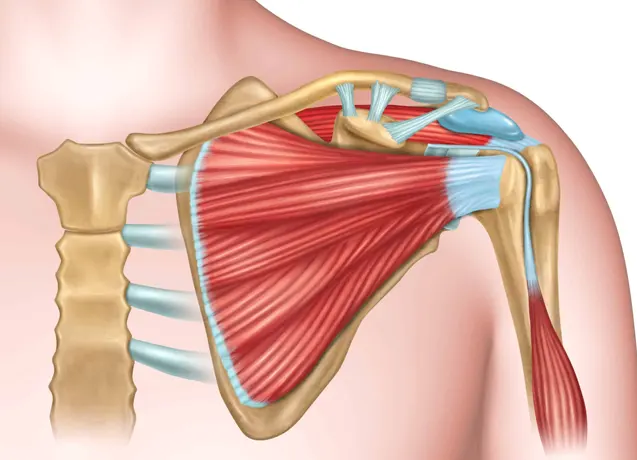
The most common symptoms include a sharp or dull pain around the shoulder that worsens with certain movements or at night, sometimes limiting movement and making simple tasks such as lifting the arm or reaching behind the back difficult. Other symptoms may include swelling, sensitivity to touch in the shoulder area, and loss of strength or rapid fatigue of the arm during use.
Shoulder tendonitis is often the result of overuse of the tendons, particularly common in athletes (such as swimmers or throwers) and in people whose work involves repetitive arm movements. Age is also a predisposing factor, as tendons become less elastic and more susceptible to injury over time.
To diagnose this condition, a healthcare professional, such as a chiropractor, will perform a thorough physical examination and may order imaging tests such as ultrasound or magnetic resonance imaging (MRI) to confirm the extent of tendon inflammation and rule out other conditions.
Subacromial bursitis
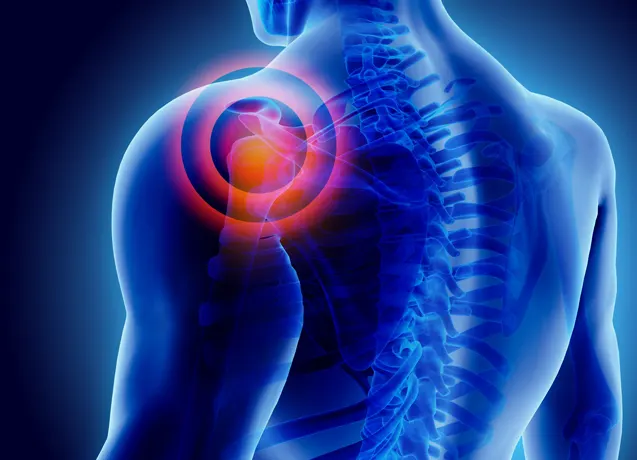
People with this condition typically experience pain that can be either acute or persistent and that worsens with movements such as raising the arm or extending it backward. This pain can be particularly severe at night and interfere with sleep. Reduced mobility due to discomfort is also common.
Subacromial bursitis is often caused by repeated irritation or pinching of the bursa by excessive or improper shoulder movements. It can also result from direct trauma, other shoulder pathology such as tendinitis, or tissue degeneration with age. People who engage in activities that require repetitive arm movements or who have physical jobs are particularly at risk.
To diagnose this condition, your chiropractor will perform a physical examination and check for pain caused by specific movements. Imaging tests such as x-rays, ultrasound, or MRI may be used to confirm bursitis and rule out other shoulder problems such as rotator cuff tendinitis (tendonitis) or tear.
Adhesive capsulitis
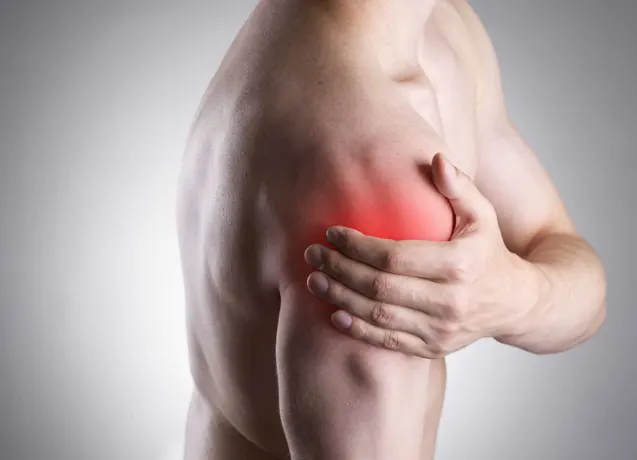
This stiffness can affect daily activities and lead to a deterioration in quality of life. People with adhesive capsulitis may find it difficult to perform activities as simple as brushing their hair or putting on a coat. Adhesive capsulitis can be divided into several stages, ranging from mild discomfort to extreme, incapacitating stiffness.
The exact causes of adhesive capsulitis are not fully understood, but it is thought to result from inflammation of the shoulder capsule, followed by excessive scarring that causes the capsule to tighten and stiffen.
Certain risk factors may increase the likelihood of developing adhesive capsulitis, including shoulder injuries, shoulder surgery, endocrine disorders such as diabetes, and prolonged periods of immobilization or inactivity.
Diagnosis of adhesive capsulitis is often based on the patient’s medical history, a physical examination of the shoulder to assess range of motion, and imaging studies such as x-rays or MRI to rule out other conditions and confirm the diagnosis.
Shoulder impingement syndrome or subacromial impingement
Shoulder impingement syndrome, also known as swimmer’s shoulder syndrome, is mainly characterized by acute pain when raising the arm above the head. This pain is often felt in front of or to the side of the shoulder, and can worsen at night, disrupting sleep.
The syndrome can also manifest itself as muscle weakness and reduced shoulder range of motion, making daily activities that require lifting the arms difficult.
The causes of impingement syndrome usually include inflammation or thickening of the rotator cuff tendons and the bursa in the subacromial space, the space between the acromion and the head of the humerus.
This narrowing of the space can be caused by overuse, anatomical abnormalities, injury, or age-related wear and tear. To diagnose this condition, your chiropractor will perform a thorough clinical examination to assess shoulder pain and range of motion.
Specific tests, such as the Neer test or Hawkins test, may be used to reproduce the pain and confirm the diagnosis. Imaging tests such as x-rays, ultrasound, or MRI may be needed to observe shoulder structures and rule out other conditions that may mimic the symptoms of shoulder impingement syndrome.
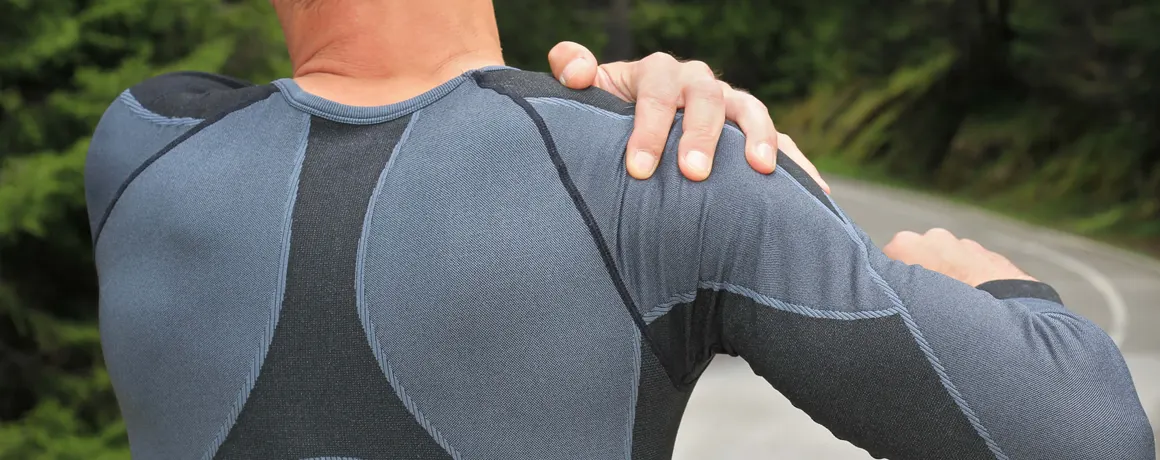
Biceps tendonitis / Biceps tendinitis
Biceps tendonitis is a condition characterized by inflammation of the biceps tendon, which connects the biceps brachii muscle to the shoulder and elbow bones.
Common symptoms include pain in the front of the shoulder, which can radiate down the arm to the elbow. This pain is often exacerbated by specific movements, such as lifting objects, turning the arm, or performing repetitive overhead movements.
Patients may also notice increased tenderness around the upper arm, stiffness in the shoulder, and sometimes a grinding, crackling or snapping sensation when the arm is moved.
The causes of biceps tendonitis can vary but are often associated with chronic wear and tear due to repetitive movements or over-exertion, particularly in athletes playing sports such as baseball, swimming or tennis. Age is also a contributing factor, as tendons lose elasticity and become more susceptible to injury over time.
Diagnosis of biceps tendonitis usually begins with a physical examination, during which the chiropractor assesses shoulder pain and mobility.
Specific tests, such as the Speed test or the Yergason test, can be used to determine the precise source of pain and confirm the involvement of the biceps tendon. Medical imaging techniques are sometimes required to visualize the condition of the tendon and rule out other shoulder pathologies.
Shoulder arthritis / Shoulder osteoarthritis
Shoulder osteoarthritis, a form of arthritis of the shoulder, can affect all shoulder joints, although it is mainly found in the acromioclavicular or glenohumeral joints.
Different types of shoulder arthritis exist. Osteoarthritis of the shoulder is a form of joint degeneration that mainly affects middle-aged and older people, although it can occur in younger individuals following trauma or repeated overload.
Symptoms of osteoarthritis of the shoulder include constant, dull pain that worsens with movement of the joint, particularly during activities involving flexion or rotation of the arms.
This pain may become more acute during periods of intense activity, and may be accompanied by noticeable stiffness, reducing the range of possible movements. Patients may also experience a grinding or cracking sensation when moving the shoulder, a phenomenon known as crepitus.
To identify osteoarthritis of the shoulder, your chiropractor will perform a thorough clinical examination, observing overall shoulder mobility, the presence of pain on palpation and assessment of shoulder range of motion.
Imaging tests such as X-rays are often required to confirm the diagnosis. These images may reveal typical signs of osteoarthritis, such as narrowing of the joint space, the presence of osteophytes (bone spurs) and changes in bone density around the joint.
These observations will help to distinguish osteoarthritis from other causes of shoulder pain, such as bursitis or tendonitis, and to develop a treatment plan tailored to the patient’s specific needs.

Risk factors for shoulder pain. Your chiropractor explains
Several risk factors can increase the likelihood of developing shoulder pain, including:

Chiropractic solutions and treatments: Your Montreal chiropractor can help relieve shoulder pain
At Tonika Chiropractic Clinic chiropractors offer a holistic, non-invasive approach to the treatment of shoulder pain. Chiropractic treatments aim to identify and correct musculoskeletal imbalances that may be contributing to shoulder pain and conditions. Here are some of the chiropractic approaches commonly used in the treatment of shoulder pain:
What to do about shoulder pain? Why consult a chiro in Montreal?
If you’re experiencing shoulder pain and are looking for relief, considering a visit to the best chiropractor could be the appropriate answer. Chiropractors are trained in the identification and treatment of musculoskeletal disorders, including shoulder disorders such as tendonitis and shoulder bursitis, and employ a variety of methods to provide targeted care for these pains.
By seeing a chiropractor, you will benefit from care that it is specifically tailored to your condition and recognized for its natural effectiveness against shoulder pain. The benefits of chiropractic treatment for shoulder pain include fast and lasting relief, making it a preferred alternative to medication.
Dr. Valery Bergeron, chiropractor, offers personalized solutions for shoulder pain. With expertise in manual therapy, mobilization and chiropractic manipulation, she is committed to providing a natural treatment for shoulder pain sufferers.
Why choose Tonika Chiropractic Clinic?
Tonika Clinique Chiropractique, the solution for your shoulder pain in Montreal and Saint-Lambert!

